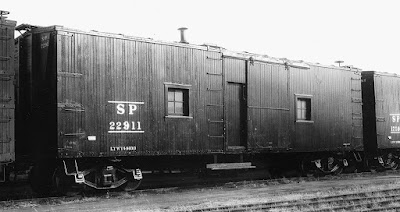I recently had an interesting question sent to me, about how Southern Pacific cabooses are assigned for operating sessions on my layout. To casual visitors, it may well look like cabooses are randomly located on trains, both on the main line and on the branch. But on the contrary, assignments are specific and have been purposefully designed.
To understand how this works, I should offer a brief summary of the cabooses that can be seen on the layout, and their backgrounds. First, for any time from 1920 to the end of the 1960s, the SP caboose fleet was dominated by wood-sheathed cupola cabooses with steel underframes, built in company shops, and classed as C-30-1, -2, and -3. Altogether, there were about 750 of these cars. I won’t go into more history than that; those interested can consult my Volume 2 of the series, Southern Pacific Freight Cars (Signature Press, 2002), which is about cabooses.
But in the late 1930s, SP began to build steel cupola cabooses, again in company shops. There were only 235 of these built, classed C-40-1 and -3; they were built with steel-wheeled trucks, permitting their use at higher speeds. And after World War II, SP began to buy commercially-built cars, this time of bay-window design, classes C-30-4, -5, and -6. By the time I model, 1953, only 135 of the bay-windows had arrived on Pacific Lines.
Additionally, I’ll mention that at times of caboose shortages (not only in wartime), SP converted other car types to temporary use as cabooses, both box cars and coaches and even a 40-foot baggage car. Once the emergencies ended, many were converted back to original configuration, assigned to work train service, or scrapped, but a few remained in use, for local trains or as transfer cabooses, well into the 1950s.
Naturally there was a hierarchy of use, with the newest cars used on faster and more important trains, down through lesser trains, to locals, and transfer service. I follow that in my layout caboose assignments.
The bottom of the barrel was the temporary caboose, most of them converted from ancient Class B-50-6 wood-sheathed box cars during World War II and remaining in service for years. They were very spartan inside and it’s no surprise that crews hated them. Here is an example from my book (Al Phelps photo, courtesy Bob Church), taken at Roseville in May 1949:
I remember being surprised when working on these cars for my book, that there were so many photos of them, but probably that is just because they were unusual. Here is another nice image, taken by Guy Dunscomb at Oroville in May, 1947, with Mogul 1754 as the power:
As it happens, Al Westerfield chose to make a resin kit for these cars, and I have one of those in my fleet. It usually resides on the caboose track in my layout’s engine terminal at Shumala, usually alongside a Class C-30-1 conventional caboose, the C-30 being the car that usually goes out on the Santa Rosalia Local.
But every now and then I assign the temporary caboose to the local, and then it does move over the layout. Here it is on a train returning through Ballard with its work completed on the branch:
I will continue this topic in a later post by discussing the other caboose classes described above.
Tony Thompson




No comments:
Post a Comment